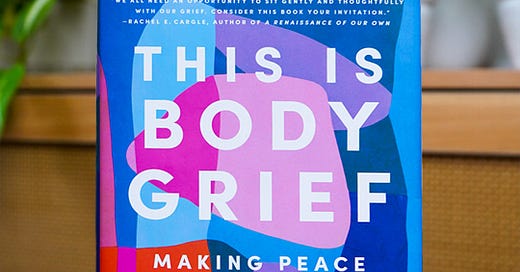Today, on Transgender Day of Visibility, we celebrate trans lives, trans joy, and the resilience of those who have fought—and continue to fight—to live authentically. But visibility alone is not enough. Not when systemic barriers still exist. Not when trans people are denied life-saving care. Not when so many are forced to justify their right to exist in a world that so often refuses to make space for them.
This is why This is Body Grief exists.
This book is for anyone who has ever felt a disconnect between their body and their sense of self—including trans folks and those living with gender dysphoria. Body grief is deeply familiar in trans communities, where the journey of affirming one’s identity often comes with layers of loss, change, and reclamation. In writing this book, I knew it had to hold space for those stories, because body grief isn’t just about chronic illness or disability—it’s about every experience where our bodies feel like sites of struggle, transformation, and longing.
In This is Body Grief, Eric’s story explores queer grief—the unique pain of feeling unseen, unsupported, and forced to fight for bodily autonomy in a world that so often denies it. Eric grew up in a place where queerness was something to be hidden, where even the idea of bodily autonomy felt distant. The grief they carried wasn’t just about their own identity, but about the relationships lost, the safety compromised, and the years spent fighting for care that should have never been withheld. Their story is a testament to the resilience of queer people, to the weight of systemic barriers, and to the courage it takes to reclaim one’s body in a world that tries to dictate who we should be.
William’s story brings to light the complexity of receiving gender-affirming, life-saving top surgery and still feeling an unexpected grief upon seeing the remnants of a past self. For William, transitioning was never a question—it was a necessity. But what he didn’t anticipate was the complicated emotions that followed. He grieved the version of himself that had fought so hard to survive in a body that didn’t feel right. He grieved the fact that even in joy, there could still be loss. His journey speaks to a truth that is rarely acknowledged: even when we move closer to feeling at home in our bodies, there can still be mourning. Mourning for what was, for what could have been, for the way society conditioned us to see ourselves.
Trans visibility is about more than just being seen. It’s about being understood, supported, and granted the care and rights that everyone deserves. And part of that understanding comes from recognizing the emotional and psychological weight that comes with bodily autonomy—the grief, the joy, and everything in between.
If you are trans, questioning, or simply seeking language for the emotions you’ve carried, This is Body Grief is here to remind you: your feelings are valid, your grief is real, and you are not alone.
This book is for you. For your friends. For your family. For anyone who wants to better understand the complexities of trans experience, queer grief, and the intricate, messy, beautiful process of coming home to oneself.
Gift it. Read it. Share it. Because trans stories deserve to be held, honored, and heard.
#TransDayOfVisibility #ThisIsBodyGrief #QueerGrief #TransJoy






Beautiful. Thank you for this post and it’s ripple effect 🫶🏼